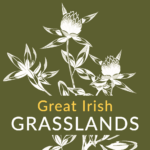Slieve Carran is also known by two other names – Keelhilla and Eagle’s Rock. It’s easy to see why it has the latter name, due to its dramatic limestone cliffs. Today Peregrine Falcons nest here, as do Ravens. At the base of the cliffs there are large areas of scrub and woodland, and the ruins of an old church and holy well. There is a magical air about the place, and a number of legends are known
to locals. Come in spring to experience a veritable sea of Wild Garlic.
The more open areas are mostly a mix of limestone pavement, grassland and scrub. In some areas, however, there are pockets of deeper soils, and here there are areas of permanent grassland. They are very species-rich, and need to be kept open by grazing (and occasional sensitive scrub removal).
The grasslands support a range of orchid species, and a wide variety of other flowers, grasses and sedges. Among the rarer orchids are the Dark-red Helleborine and the Frog Orchid. An experimental grazing exclosure stands in one of the grassland pockets, and can be seen from one of the walking trails. This has been surveyed for its plants and snails a number of times since its erection in 2005, providing invaluable scientific data on how important grazing management is for maintaining the diversity of such habitats.
